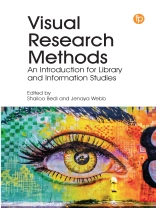Visual research methods (VRM) comprise a collection of methods that incorporate visual elements such as maps, drawings, photographs, videos, as well as three-dimensional objects into the research process. In addition, VRM including photo-elicitation, photovoice, draw-and-write techniques, and cognitive mapping are being leveraged to great effect to explore information experiences to investigate some of the central questions in the field; expand theoretical discussions in LIS; and improve library services and spaces.
Visual Research Methods: An Introduction for Library and Information Studies is the first book to focus on visual methods in LIS, providing a comprehensive primer for students, educators, researchers and practitioners in the field. Contributed chapters in the book showcase examples of VRM in action and offer the insights, inspirations, and experiences of researchers and practitioners working with visual methods. Coverage includes:
– an introduction to visual research methods including a discussion of terminology
– an overview of the literature on VRM in libraries
– methodological framing including a discussion of theory and epistemology
– practical and ethical considerations for researchers embarking on VRM projects
– chapters showcasing VRM in action including drawing techniques, photographic techniques, and mixed methods
– six contributed chapters each showcasing the results of visual research methods, discussions of the techniques, and reflections on VRM for research in information studies.
This book will provide a strong methodological context for the adoption of visual research methods in LIS and feature examples of VRM ‘in action.’ It will prove to be a must-have reference for researchers, practitioners, instructors, and students who want to engage with visual research methods and to expand their methodological toolkit.
Tabela de Conteúdo
Introduction: An Invitation to Visual Research Methods, Shailoo Bedi and Jenaya Webb
Part 1 – A Primer on Visual Research Methods in LIS
1 – A Brief Introduction to Visual Research Methods in LIS, Jenaya Webb and Shailoo Bedi
2 – Visual Research Methods: Discovery, Shailoo Bedi and Jenaya Webb
Part 2 – Visual Research Methods in Action
3 – Librarian, Illustrated: The Draw-and-Write Technique as a Visual Method for Libraries, Jenna Hartel and Deborah Hicks
4 – Rediscovering Community Heritage through 3D Laser Scanning and Visualisation, Elizabeth Tait
5 – Making as Storytelling: Using Draw-and-Write and Object Elicitation in the Design and Study of a Library Makerspace, Jess Whyte and Chelsea Misquith
6 – Windows into Library Experience: The Value of Visual UX Research Methods, Andy Priestner
7 – Digital Storytelling, Archival Research and ‘Layers of Practice’: A Critical Pedagogical Approach to Visual Literacy in University Archives and Special Collections, Angela Fritz
8 – Navigating the Thresholds of Information Spaces: Drawing and Performance in Action, Rebecca Noone
Sobre o autor
Dr. Shailoo Bedi works at the University of Victoria (UVic) as both Director, Academic Commons and Strategic Assessment with the Libraries as well as Director, Office of Student Academic Success with Learning, Teaching Support & Innovation. She holds a Ph D in Education, Curriculum and Instruction, and is an adjunct professor with UVic’s Educational Psychology and Leadership Studies department. Shailoo’s research interests include the construction and issues of identity for racialized minority leaders, as well as student experience with learning spaces, student research creation, and visual research methods. She is passionate about fostering intellectually engaging and inclusive learning environments.
Jenaya Webb is the Public Services and Research Librarian at the Ontario Institute for Studies in Education (OISE) Library at the University of Toronto. She earned her MA in Anthropology at the University of Alberta where she examined the power of images as research evidence both to measure landscape change and to generate stories of place in Jasper National Park, AB. Since completing her MLIS at the University of Toronto, she has worked to bring visual methods and approaches to the library context to explore user experience, wayfinding, and meaning-making in library spaces.












